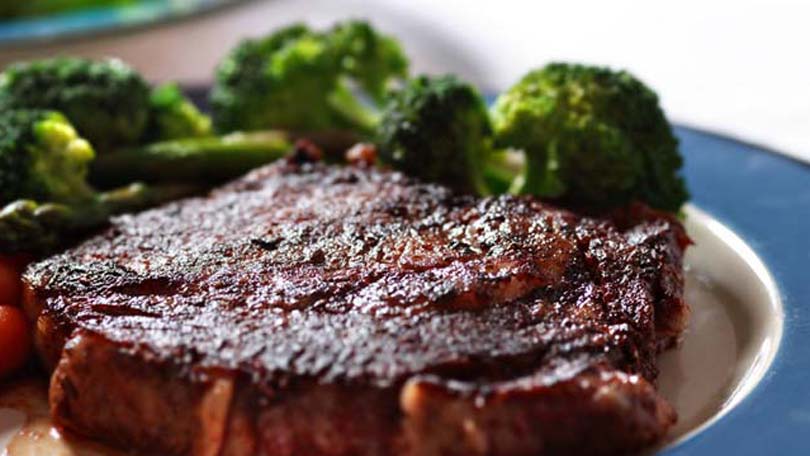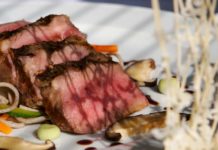
You’re in a very nice steakhouse. Great music is complimenting the rustic décor. You’ve ordered the King of Steaks, a Prime-Grade Ribeye. You watch in glorious anticipation as they bring the plate to your table. As you take the first cut at this succulent-looking treasure, a flood of delicious juice pours from it and coats the bottom of your plate. Great, right?…….Waaay Wrong! They have completely ruined this otherwise delectable morsel by serving it before it has properly rested. It will be dry in the inside, with as much as 25-30% lost flavor. I would either send it back, or more likely, just tip the waiter, or waitress (it wasn’t their fault), pay for whatever I have actually consumed (tea, coffee, appetizers), and leave, probably never to return. It is bad enough for an individual to to commit this heinous culinary crime from a lack of knowledge, but a professional cook should know better.
Even among professional grillmiesters, it is appalling to me how many do not understand why meat should rest before it is served. More delicious meat has been destroyed by this error than by any other mistake cooks have made in the entire known history of cooking. If you never learn anything else about food, please commit to memory the fact that most meat needs to rest before serving. Here’s why:
Meat is composed of protein chains (coils, actually) made up of amino acids. Amino acids, when heated, undergo a change called denaturing, which means their basic configuration changes somewhat, along with some of their physical characteristics. In the case of cooking, the protein chains contract, exerting pressure on the water contained within the molecules. Water is not compressible, so it has to go somewhere. One of the laws of physics is that non-compressable fluids will move from areas of high pressure to areas of low pressure, in this case, a lower temperature. So what happens is all the juice moves from the surface areas of the meat, to the center, where it is cooler. The ‘sizzle’ you hear when meat is placed on a hot grill is some of the juices being forcefully expelled from the tissues before they have time to move to the center. This is not necessarily a good thing, but a small amount is unavoidable.
While we are cooking our cut of meat to an internal temperature of 180°F, the outside tissues can reach 200°F or higher. So, when we remove the meat from the heat, most of the juice is at the interior end of the protein fibers. If you then immediately slice into the muscle fibers, exposing them to cooler air, the juices will rush out in a flood, much like slicing into the side of a full plastic coke bottle. 15 to 20% of the flavor goes out with the juice. And the damage is irreparable. Simply dipping the meat in the juice as you eat will not place it back in the fibers where it belongs. The meat is permanently ruined.
When meat is removed from the heat, and cools, the process is reversed. The first thing that happens, is that the internal temperature of the meat continues to rise after cooking has stopped, due thermodynamics (called Carry-Over Cooking by professional grillers). Now the juice will move back to the outside of the meat, as it cools, and the internal temperature rises, evenly distributing the juice and flavors throughout the meat. When the meat is sliced, the juices will tend to stay in the meat where they belong, due to surface tension (another physics principle). You now have a moist, succulent piece of meat that has the maximum flavor possible. Another benefit of resting meat is that it allows the temperature of the meat to even out, so that the outside is not hotter than the inside. This will also greatly improve the flavor of your culinary masterpiece.
You can prove this to yourself very easily. Get a good cut of meat that you really enjoy eating (boneless if possible) and cut it into 6 even pieces. Cook these 6 pieces equally, at the same time, and place them on 6 separate plates. Now, cut into one immediately and observe the results, and taste. You will most likely wind up with a gush of juice in the plate. Next, slice into the other cuts at intervals of 3 minutes each, and observe the results. You will find that the longer the meat sets, the more juice it retains, and the more flavorful it will be.
The amount of resting time depends on the size of the piece of meat, and the temperature it was cooked to, but even thin cuts like chicken breasts and hamburgers benefit from 5 minutes of rest before serving. The times are not exact, but a good rule of thumb is that steaks, chicken pieces or breasts, burgers, pork chops, and fish should all rest for at least 5-10 minutes before serving. For larger cuts such as roasts, turkeys, and hams, 20-30 minutes is about right. Be sure to place the meat in a juice-catching tray and cover loosely with foil.
The next time you see juices flowing from a steak that you have ordered, you will know that it has been abused, and you can impress the cooking staff with your new-found knowledge. You can proceed with confidence in explaining to them why meat should rest before it is served.





